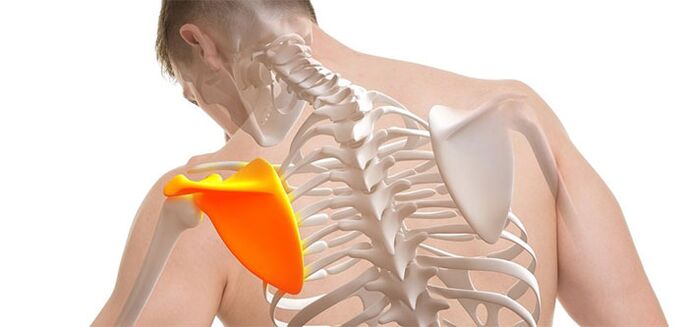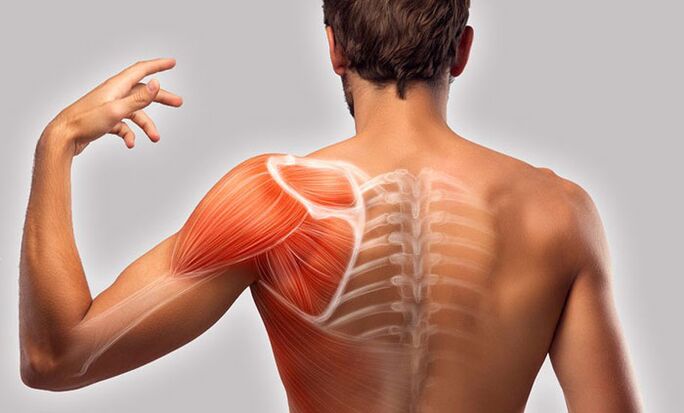Patients rarely pay adequate attention to recurrent pain in the shoulder blades. However, this symptom is a "wake-up call" to serious changes not only in the locomotor system but also in the internal organ complex. Such conditions can put the patient at risk for disability and death. How to not miss the disease and cure back pain in the shoulder area, read on.

Etiology
The spine is a major component of the human musculoskeletal system. So during statics or dynamics, the lion’s share of the pressure falls on the spine. It is therefore not surprising that pain in the shoulder area is a common cause of seeing a doctor.
However, the syndrome of pain is quite variable: often the pain is not caused by the spinal cord itself, but by a violation of the functions of the internal organs. This fact makes it difficult to diagnose the root cause of pain syndrome and leads to incorrect treatment.
Among the main causes of pain, a distinction is made between pathologies of the locomotor and internal systems.
The first group includes:
- osteochondrosis;
- spinal deformities;
- trauma and spondylolisthesis;
- spondylosis;
- osteoporosis;
- ankylosing spondylitis.
Among the non-vertebral causes, diseases of the internal organs are the most common (pneumonia, myocardial infarction, intercostal neuralgia, gastric ulcer, cholecystitis). In addition, cancerous processes or mental lability (fibromyalgia, psychogenic pain) can cause pain.
Pain variations
Why does my back hurt in the shoulder area? In general, pain syndrome can be localized directly in and between the shoulder blades. The pain is bilateral (with scoliosis) or mainly on one side (gastric ulcer, cholecystitis).
Back pain between the shoulder blades can be acute (occurs suddenly with a rapid increase in strength) or chronic (weak and prolonged). In practice, the main difference is that the patient can pinpoint the time of onset of acute pain syndrome. It will be difficult to remember the circumstances in which chronic pain develops.
Possibilities of pathology
Many diseases can cause back pain in the shoulder blades, but we will focus on the most common of these.
- Osteochondrosis.Osteochondrosis is a disease in which the intervertebral disc "ages". In advanced cases, such abnormalities lead to prominence of the hernia of the disc. It occurs when you are in an uncomfortable position for a long time, and you can add tangible weakness in your back muscles, disturbances in your sense of temperature and pain.
- Spinal deformities.One of the causes of pain between the shoulder blades and in the area is the curvature of the spine. The pain usually provokes kyphosis (curvature, hump) or scoliosis (C, S or Z-shaped spine). Significant deformities of the spine cause painful pain that is exacerbated by physical activity. Episodes of respiratory failure (shortness of breath, inability to "breathe deeply") are common. The clinic is accompanied by increased fatigue and headache. In rare cases, the chest bends.
- Injuries.Acute pain often occurs directly with damage to the spine or shoulder blades. Similar injuries occur during falls from a height, collision with a blunt object, transport, or industrial accidents. Spinal cord injuries are associated with palpable pain, reflexive contractions of the back muscles, and bruises. In some cases, the attachment of neurological pathology is possible. If the shoulder blade is injured, the pain is acute, exacerbated by swinging the arms. It is sometimes combined with bleeding in the shoulder joint cavity - hemarthrosis.
- Spondylosis.Spondylosis is called senile destructive processes in the spine. Usually, bone tissue grows in the area of the intervertebral joints - osteophytes are formed, which can be complicated by the growth of the vertebrae together. In such cases, severe pain, neurological and vascular disorders occur.
- Osteoporosis.Osteoporosis is a disease associated with a decrease in the density of the bone system. Usually, back pain in the area of the shoulder blades occurs when a fracture of the thinned thoracic vertebrae occurs. The curvature of the posture appears - the development of scoliosis and / or kyphosis. In some cases, the disease is complicated by radical syndrome (loss of motor activity and sensitivity).
- Ankylosing spondylitis. . . Ankylosing spondylitis is a disease that affects the intervertebral joints. Usually, the clinic begins with pain between the shoulder blades or in the lower back. The pain is accompanied by stiffness of movement, which intensifies after a night’s rest. With the development of the pathology, the spine deforms, curving, leading to curvature of the chest and respiratory failure. In such a pathological situation, ankylosis (immobilization) of the intervertebral joints occurs, which causes the patient to no longer be able to bend. In this case, the disease can also affect the cardiovascular system and the urinary system.
- Diseases of the internal organs.In pneumonia (pneumonia), the detailed clinical picture is characterized by fever, sputum production, and unilateral chest or back pain in the shoulder area. During a heart attack, the pain is sharp (stinging, burning), occurs in the chest, and radiates toward the left scapula and upper limb. The pain syndrome associated with intercostal neuralgia is acute and pervasive, with attacks that disrupt the patient's breathing. The pain occurs along the ribs and is distributed below the shoulder blades, clavicle and lower back. In the case of a stomach ulcer, the pain is dull, localized in the upper abdomen, often accompanied by "hungry" pain (with long breaks between meals). In this case, the disease is characterized by indigestion, nausea, vomiting, and sour belching. Sometimes they bleed from the ulcer: patients feel dagger pain that disappears at the height of the bleeding. Vomiting and stools turn dark (almost black) due to blood stains. Gallbladder inflammation (inflammation of the gallbladder) is a characteristic appearance of paroxysmal pain syndrome in the right hypochondrium that extends to the right side and towards the scapula. The clinic of the disease includes indigestion, the provocative factor of which is the consumption of fatty and fried foods. Sometimes vomiting appears with bile impurities.
- Tumors.Pain in the area of the shoulder blades can occur with cancer of the vertebrae or nerve sheaths (neuroma). Metastases (daughter tumors) from the affected prostate or mammary glands can spread to the vertebral region. In this case, the tumor process is characterized by an asymptomatic course, and the onset of pain is accompanied by an increase in the neoplasm and pressure on the neurovascular bundle. Cancer can be suspected based on "watchdog symptoms": pain, weight loss, fever, and weakness for no apparent reason.
- Mental lability.Psychiatric instability in the face of stress and emotional outbursts can manifest as psychogenic pain. It is at the heart of overall health: patients may experience a range of sensations that cannot even be treated with painkillers. Stressful situations also provoke another idiopathic (unreasonable) pain - fibromyalgia. The disease progresses in the background of prolonged pain sensations, intensifying at certain (triggering) points.
Diagnostics
Radiography is the gold standard for examining the spine. Computed tomography can be used to determine the cause of vertebral pain. Ultrasound diagnostics or MRI is used to study other organs and systems. Laboratory or other instrumental testing methods may be required to rule out concomitant pathology.
Treatment
These conditions require a special treatment plan, only a doctor can prescribe medication.
- Osteochondrosis.Non-steroidal anti-inflammatory drugs and analgesics are used as drug therapy for the relief of pain. Physiotherapy, physiotherapy and massage are also effective. In the later stages of the disease, surgery is recommended to remove the hernia sac.
- Spinal deformities.Conservative therapy for curvature of the spine consists of the use of supportive devices (corsets, bandages). Sufficient activity, massage and physiotherapy are also required (paraffin application, electrical stimulation). In the case of significant deformity, surgical treatments are indicated to fix the spine in an anatomically appropriate position.
- Injuries.Minor injuries are treated with rest, warming and massage, and more severe injuries may require traction. If conservative methods are ineffective, the spine is reconstructed by an operative method.
- Spondylosis.Treatment of this pathology is aimed at slowing the progression of the disease. Thus, hyaluronic acid injections, chondroprotectors, physiotherapy (shock wave therapy), and physiotherapy exercises are prescribed. With severe pain syndrome, blockade is performed with painkillers.
- Osteoporosis.Treatment for osteoporosis includes high-dose calcium and vitamin D supplements. Hormone therapy with female sex hormones, thyroid and other hormones is also possible.
- Ankylosing spondylitis.Inflammation and pain are controlled by anti-inflammatory therapy. An antimetabolite belonging to the group of structural analogues of folic acid is prescribed to modify the immune response. During remission, physiotherapy, breathing exercises and therapeutic massage are performed.
- Diseases of the internal organs.Treatment of pneumonia includes antibacterial agents as well as medications to relieve bronchospasm. During the rehabilitation period, vibration massage and therapeutic exercises are prescribed. Intercostal neuralgia is treated with warming and anti-inflammatory ointments. Distraction therapy with topical remedies, red pepper extract or bee venom is often used. Treatment of gastric ulcer consists of combination antibiotic therapy and drugs that reduce the acidity of the stomach. Help with cholecystitis includes the use of antispasmodics and bile medications. In some cases, antibiotic therapy may be required. In the presence of large stones in the gallbladder, the removal of the latter is recommended - cholecystectomy.
- Tumors.Treatment of tumor processes consists of chemotherapy with anti-tumor agents and surgical removal of the neoplasm (if possible).
- Mental lability.Mental lability requires intensive psychotherapy and the use of antidepressants or anxiolytics. Limiting psycho-emotional stress is an important part of treatment.

How to prevent?
To prevent back pain in the shoulder blades, lifestyle changes are needed: to increase the nutritional value of the diet, to exercise, to quit smoking and drinking. It is important to recognize and treat chronic diseases in a timely manner and to avoid stress overload.
Remember, pain is not a disease in itself, but a manifestation of a much more serious pathology that requires diagnosis and proper treatment!

























